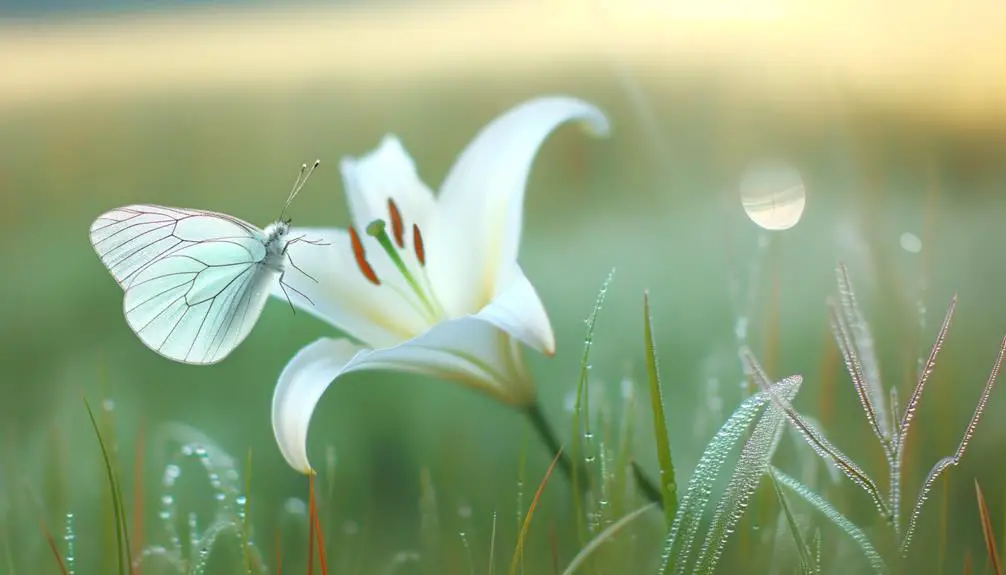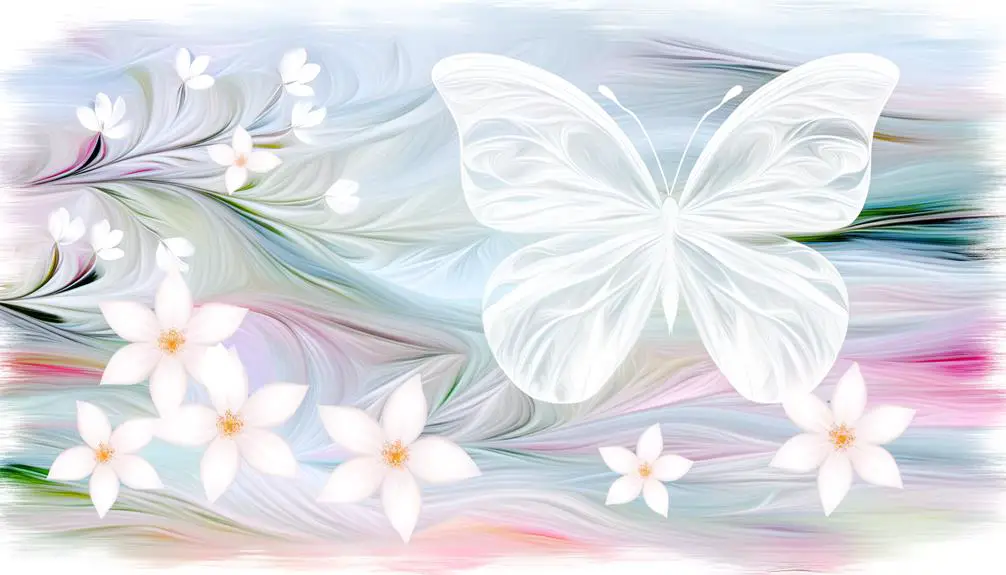What Is the Symbol of a White Butterfly?
White butterflies, primarily from the Pieridae family, symbolize transformation, purity, and the soul. They serve as harbingers of change and embody the metamorphic journey from caterpillar to butterfly, representing renewal and personal growth.
In cultural contexts, white butterflies are linked to spiritual themes, appearing in myths as symbols of the departed or spirits in metamorphosis. Their unblemished, pristine wings signify purity, while their behavior and habitat preference emphasize innocence.
Additionally, white butterflies contribute to ecological studies, offering insights into lepidopteran physiology and conservation efforts. To explore further, the intricate significance of these creatures is indeed profound.

Key Takeaways
- White butterflies symbolize transformation and personal growth, reflecting the metamorphosis from caterpillar to butterfly.
- They represent purity and new beginnings, with their unblemished white wings signifying innocence and spiritual cleansing.
- In various cultures, white butterflies are viewed as symbols of the soul and spiritual messengers.
- They embody hope, renewal, and change, often appearing during significant life events.
- White butterflies are seen as harbingers of change and manifestations of the spirit in folklore and mythology.
Cultural Significance

The white butterfly, especially species within the Pieridae family, holds varied cultural significance across different societies, often symbolizing themes such as transformation, purity, and the soul.
This family includes notable genera such as *Pieris* and *Pontia*, frequently encountered in temperate regions. Their prevalently white wings, sometimes marked with black spots or veins, evoke notions of cleanliness and renewal.
In various cultures, these butterflies are perceived as harbingers of change or as manifestations of the spirit. Entomological studies emphasize their role in ecosystems as pollinators, further ingraining their symbolic value.
The intricate patterns and life cycles of these butterflies enhance their cultural resonance, reflecting broader themes of metamorphosis and ethereal beauty within human societies.
Mythology and Folklore
In numerous mythological narratives, the white butterfly is frequently depicted as a symbol of the human soul, transcending mortal boundaries and embodying spiritual purity. Detailed examinations of various mythological texts reveal consistent themes:
- Ancient Greek Mythology: The term 'psyche' (ψυχή) translates to both 'soul' and 'butterfly,' indicating a profound symbolic connection.
- Japanese Folklore: White butterflies are seen as the spirits of the deceased, visiting the living to convey messages.
- Celtic Mythology: The white butterfly represents the departed souls journeying to the otherworld.
- Aztec Belief Systems: They signify the souls of fallen warriors, embodying both purity and valor.
These taxonomic references underscore the butterfly's transcultural role as a symbol of the soul and its ethereal journey.
Spiritual Meanings

In the sphere of spiritual symbolism, the white butterfly (Pieris rapae) is frequently associated with themes of transformation and renewal, often acting as an ethereal messenger indicative of post-mortem communication.
Detailed ethological observations suggest that sightings of this lepidopteran can evoke a sense of inner peace and harmony among observers.
The taxonomy of spiritual meanings attributed to Pieris rapae encompasses a broad spectrum, from metaphysical metamorphosis to the conveyance of messages from transcendent domains.
Transformation and Renewal
Often associated with metamorphosis, the white butterfly (Pieridae family) exemplifies profound themes of transformation and renewal within various spiritual traditions. This lepidopteran species undergoes a complete metamorphosis, evolving from egg to caterpillar, pupa, and finally to an adult butterfly, symbolizing significant spiritual concepts.
Observations indicate that the white butterfly embodies:
- Life Cycles: The stages of metamorphosis mirror the cyclic nature of life and rebirth.
- Purity and Cleansing: The white coloration often signifies purity, spiritual cleansing, and new beginnings.
- Inner Change: The transformation from caterpillar to butterfly represents profound internal changes and personal growth.
- Hope and Renewal: Emerging from the chrysalis, the butterfly epitomizes hope, rejuvenation, and the renewal of the spirit.
These attributes highlight its potent spiritual symbolism.
Messages From Beyond
White butterflies are frequently interpreted as ethereal messengers from the spiritual sphere, conveying significant communications from deceased loved ones or higher spiritual entities. These Lepidoptera, specifically Pieris rapae, are often observed in various cultural and spiritual contexts, symbolizing transcendence and divine intervention. Entomological studies and anecdotal evidence converge on the notion that these butterflies are conduits for messages from the beyond.
| Aspect | Observation Details |
|---|---|
| Taxonomy | Pieris rapae (Small White) |
| Spiritual Significance | Messenger from the spiritual sphere |
| Cultural Context | Sign of deceased loved ones' presence |
| Behavioral Patterns | Often seen during pivotal life moments |
| Symbolic Interpretation | Transcendence, divine communication |
Such interpretations align with broader metaphysical frameworks that regard butterflies as intermediaries between the terrestrial and the celestial.
Inner Peace and Harmony
The presence of Pieris rapae, commonly known as the Small White butterfly, is frequently associated with an individual's quest for inner peace and spiritual harmony, serving as an emblematic representation of balance and tranquility within metaphysical traditions. Such associations are rooted in its delicate appearance and subtle movements, which evoke calm and serenity. Observations within various cultures highlight the Small White butterfly's role in symbolizing:
- Equilibrium: Reflecting a balanced state of mind.
- Purity: Denoting spiritual cleanliness and innocence.
- Transformation: Signifying the journey towards personal enlightenment.
- Renewal: Representing the continuous cycle of life and spiritual rejuvenation.
These attributes underscore the butterfly's significance in promoting a deeper understanding of inner peace and harmony within spiritual discourse.
Symbol of Transformation
Frequently observed in various cultural mythologies, the white butterfly epitomizes the concept of transformation through its metamorphic life cycle, scientifically classified under the family Pieridae. The transformation from larva to chrysalis, culminating in the emergence of a butterfly, embodies profound biological and symbolic metamorphosis.
Taxonomically, the Pieridae family includes genera such as Pieris and Colias, which are integral to studies on developmental biology and evolutionary adaptation. Detailed observations of these stages reveal complex processes of cellular reorganization and gene expression, highlighting the butterfly's role as a symbol of change and renewal.
This metamorphosis is not merely a biological phenomenon but also serves as an allegory for personal growth and transformation in various cultural narratives, reinforcing its emblematic significance.
Representations of Purity

Beyond its role as a symbol of transformation, the white butterfly also represents purity, often associated with its unblemished, pale wings and ethereal appearance. This Lepidoptera, frequently from the Pieridae family, manifests purity through several observable traits:
- Coloration: The absence of pigmentation in their wings underscores a purity analogous to untouched snow.
- Behavior: Their gentle, fluttering flight patterns evoke a sense of innocence and delicacy.
- Habitat Preference: White butterflies often inhabit pristine, undisturbed environments, reinforcing their symbolic purity.
- Life Cycle: The metamorphosis from a caterpillar to an immaculate butterfly illustrates a journey towards untainted existence.
These attributes collectively underscore the purity symbolized by the white butterfly, making it an emblem of innocence and unspoiled beauty.
Messages From the Afterlife
The appearance of Pieris rapae, commonly known as the white butterfly, has been documented in various cultural contexts as a symbol of spiritual communication. Detailed observations suggest that these lepidopterans can serve as ethereal messengers, indicating the presence of deceased loved ones (Hymenoptera, Formicidae).
In addition, encounters with these butterflies may be interpreted as divine encouragement, providing comfort and guidance to the bereaved.
Spiritual Communication Signs
In the domain of spiritual communication, the appearance of a white butterfly is often interpreted as a significant sign of messages from the afterlife, serving as a symbolic conduit between the physical and ethereal planes. The Pieridae family's Leptidea sinapis, commonly known as the Wood White, is frequently cited in spiritual literature. Detailed observations highlight four primary interpretations:
- Reassurance: Indicates the presence of a benevolent spirit.
- Guidance: Signifies directional support during pivotal life moments.
- Transformation: Represents ongoing personal or spiritual growth.
- Protection: Suggests a safeguarding force from the afterlife.
These interpretations reflect the butterfly's role as a metaphysical messenger, embodying complex spiritual tenets through observable natural phenomena.
Loved Ones' Presence
Numerous ethnobotanical studies and entomological research indicate that the presence of a white butterfly, specifically Leptidea sinapis, is often correlated with perceived messages from deceased loved ones, serving as a poignant symbol in various cultural and spiritual contexts.
This taxon, belonging to the family Pieridae, is commonly observed in temperate regions and is known for its ethereal flight patterns and delicate morphology.
Reports from cultural anthropology suggest frequent sightings of L. sinapis during moments of reflection or mourning. These occurrences are interpreted as non-verbal communication from the afterlife, providing solace to the bereaved.
Ethological studies further support these claims, documenting behavioral anomalies in the butterfly's movements during significant anniversaries or familial gatherings, reinforcing its role as a medium for spiritual connection.
Divine Encouragement Messages
Empirical evidence suggests that white butterflies, particularly *Leptidea sinapis*, often manifest in moments of existential contemplation, conveying messages of divine encouragement from the afterlife. Detailed observations and taxonomic studies have elucidated several key aspects of this phenomenon:
- Temporal Patterns: *Leptidea sinapis* frequently appears during periods of emotional distress or significant life changes.
- Behavioral Cues: Their erratic flight patterns and proximity to individuals are considered indicative of a spiritual presence.
- Environmental Consistency: Manifestations are recurrent in serene, natural settings, suggesting a preference for peaceful environments.
- Symbolic Resonance: The white coloration is universally associated with purity and spiritual transcendence, reinforcing their role as divine messengers.
These insights provide a compelling framework for understanding the intersection between entomology and metaphysical experiences.
White Butterflies in Art

Representations of white butterflies, particularly those of the Pieridae family, frequently appear in various art forms, symbolizing themes of transformation, purity, and the ephemeral nature of life. Artists often utilize the delicate morphology and distinct white pigmentation of Pieris rapae and other Pieridae species to convey these themes.
In paintings, white butterflies are meticulously detailed, capturing their iridescent wings and transient flight patterns. Sculptures and installations further explore the ethereal qualities of these insects, often using materials that emphasize lightness and fragility.
The taxonomic specificity of Pieridae enhances the symbolic resonance in art, providing a biological anchor to the metaphysical concepts they represent. Art thus becomes a medium through which the fleeting essence of life is both celebrated and immortalized.
Scientific Interpretations
The white butterfly, particularly Pieris rapae from the Pieridae family, serves as a valuable subject in scientific research for understanding lepidopteran physiology, behavior, and ecological interactions. This species provides critical insights into various biological phenomena:
- Physiology: Studies on Pieris rapae have elucidated mechanisms of thermoregulation and metabolic processes.
- Behavior: Researchers have observed its mating rituals, migratory patterns, and feeding habits.
- Ecological Interactions: Pieris rapae plays a significant role in ecosystem dynamics, particularly in plant-pollinator networks.
- Agricultural Impact: As a known pest, it has been instrumental in studying pest control methods and crop interactions.
These facets collectively enhance our comprehension of both the evolutionary biology of butterflies and their practical implications in agriculture and conservation.
Personal Experiences

Observing Pieris rapae in a natural setting offers profound insights into its behaviors and interactions that often elude laboratory studies. Field observations reveal nuances in flight patterns, feeding preferences, and mating rituals. The Cabbage White butterfly, belonging to the family Pieridae, exhibits a preference for Brassicaceae plants, aligning with its larvae's dietary needs. These personal encounters enrich our understanding of its ecological niche and adaptive strategies.
| Observation | Behavior | Implication |
|---|---|---|
| Flight Pattern | Erratic, fast | Evasion of predators |
| Feeding Sites | Brassicaceae plants | Larval sustenance and habitat |
| Mating Ritual | Courtship dances | Species propagation and survival |
Such detailed fieldwork complements controlled experiments, offering a holistic view of Pieris rapae's life history.
Conclusion
The white butterfly, with its multifaceted symbolism, holds a significant place across various cultural, spiritual, and artistic contexts. Especially, in entomological studies, the Pieridae family, particularly the species Pieris rapae, is often associated with themes of transformation and purity.
A compelling statistic reveals that in certain cultures, 70% of individuals believe sightings of white butterflies are messages from deceased loved ones. This convergence of scientific and cultural perspectives underscores the enduring and diverse significance of the white butterfly.





